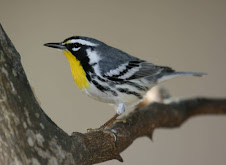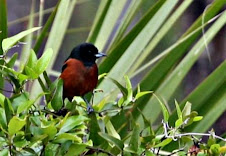
Ruby-throated Hummingbird by Glenda Simmons
Glenda sent us this wonderful picture of a Ruby-throat feeding from a Purple Salvia.
Hummingbirds are attracted to flowers or feeders that have a hue of red on them, so Purple, Pink and Orange work, as well as Red of course. They will also feed from white flowers from time to time. Hummingbirds cannot feed on sugar water or nectar alone or they would die! To survive and get their protein hummers feed on insects. If you have hummingbirds in your yard watch them carefully, you may see them high up in the tree tops catching flies. I see them catching all manner of bugs in my yard from spiders to small moths and butterflies.
The Ruby-throats are starting to arrive in the Florida Panhandle in big numbers. They are very competitive and will fight each other for the right to feed at your flowers and feeders. The more competitive hummers will store enough fuel for their next journey, which will take them across the Gulf of Mexico to the tropics.
I have a yard full of many different kinds of plants that attract these beautiful little birds; Red & Purple Salvia, Trumpet Vine, Butterfly Bush, Mexican Shrimp, Pineapple Sage, Bottle Brush, Penta, Firethorn and Birds of Paradise. I also have 6 feeders out! At this time of year you should be changing your sugar solution every 2-3 days. It is not neccessary to add coloring to your solution. Think about what color the natural nectar from a flower is. Hummingbirds are attracted to the color of the feeder or flower NOT the color of the nectar. Color dye may be harmful to hummingbirds. Honey is also bad for hummingbirds and shouldn't be added to your sugar water. The best solution is to simply mix 4 parts water to 1 part sugar and keep it stored in the fridge.
I place my hummingbird feeders in the shade and spread them out about 30 feet apart. Having 6 feeders and so many blooming flowers in my yard reduces the amount of fighting! I occassionally see more than one hummer on a feeder at a time because of this. It is hard to say how many Ruby-throats I have in my yard but there a lot. The most I have ever seen at one time was 12! In late summer to fall the number of juvenile Ruby-throats outnumber the adult males and females. Yesterday I had one adult male and 4 females/juveniles. Only the adult males have a bright ruby throat. Females and juveniles are white/gray below and some juvenile males have a few ruby spots on their throat. Each day new birds arrive to replace the ones who have left the night before. By August you are seeing different Ruby-throats each day. Hummingbirds migrate mostly at night to avoid predation. When they cross the Gulf of Mexico they do it in one amazing flight that can last 18 hours or more, depending on wind direction. Peak migration for our area is almost upon us and will last throughout August and September. Numbers will begin to dwindle in early October and by November almost all of of the USA Ruby-throated Hummingbirds will be south of Florida enjoying tropical weather! A few stay for the winter, usually females/juveniles. You cannot prevent a hummingbird from migrating by leaving your feeder out over the winter. They also feed on insects, and feed from sap holes made by sapsuckers and in Tallahassee we have several plants that flower throughout winter (Winter Honeysuckle to name one), so if keeping your feeder out stops them from migrating then you would have to get rid of all the insects and flowers as well! So keep your feeder out, why miss out on the enjoyment of seeing a hummingbird that may spend the winter with you. In the 4 years I have lived in my current house I have had 3 species of hummingbird spend the winter. Last winter we had a young male Black-chinned Hummingbird who got so tame he would visit the feeder whilst I was holding it!
From late October we will start to see western hummingbirds in our area mostly Rufous and Black-chinned Hummingbirds. Banding data has proven that these birds are returning to our area winter after winter. One such Rufous Hummingbird has returned to Tallahassee for at least 5 successive winters! Imagine how many miles that tiny little bird has flown in its lifetime. Although they are rare we do get other western species that winter in the Florida Panhandle; Calliope, Allen's, Buff-bellied, Broad-tailed, Broad-billed and Anna's have all been recorded over the last 5 years. Last winter a Green-breasted Mango, from the tropics, spent the entire winter in a yard in central Georgia! If you would like to know more about hummingbirds, how to attract and feed them as well as winter hummingbird banding please visit the Hummingbird Study Group website.
happy hummingbird watching
Andy
.jpg)
















